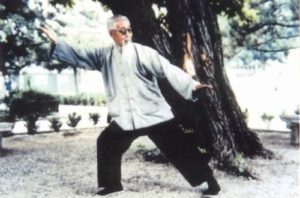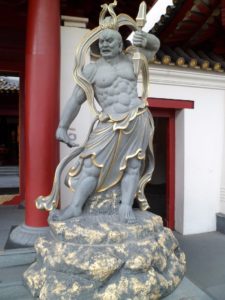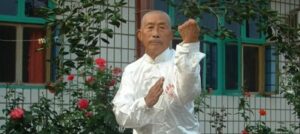In our Xingyi Quan, when you first begin there are two very important things to learn: the mother posture (母式) and the mother fist (母拳). The old saying is “万法源于三体式” – 10,000 methods all originate from San ti shi. The mother posture is called Santi Zhuang Gong, a type of standing meditation. It seems simple and boring but Xingyi Quan ancestors have always insisted that ” Santi Zhuang Gong is a treasure. Only when you have mastered it could you become any good”. M Shang equally focused on its importance setting very specific requirements for its practice. He was concerned that whilst many imitate they do not understand the internal and structural mechanics that allow Zhuang Gong to be truly effective for combat or health.
The practice of Santi Shi (Xingyi’s fundamental stance) is crucial for anyone wanting to study Xingyiquan. However the requirements to practice it correctly are very specific and many guiding principles were passed down from our ancestors as to take note when practicing. There are three key poems to help in this practice this includes the Eight Character Poem and the Three treasures nine postures song. However whilst they guide some aspects there are additional principles. The Eight Characters are Thrust, Arc, Round, Agile, Embrace, Hang, Bend, & Straight. The Stake Method type of Boxing is standing for fixed periods of time. These Eight Characters are must have, therefore, so as to store up Li & nourish Qi, causing me to have no handles for the enemy to use. Thus the Eight Characters each have three types, divided which relate it’s differences:
八字为:顶、扣、圆、敏、抱、垂、曲、挺、是也。
| 一曰三顶 头向上顶:有冲天之雄,周身之主,后三关易通(养性) 手掌外顶:有推山之功,气贯全身,力达四梢(肢体) 舌上顶:有吼狮吞象之意,上升之气下行入丹田(固命) | 五曰三抱 丹田要抱:气不外散,击敌必准。 心气要抱:遇敌有主,临变不变。 两肋要抱:出入不乱,遇敌无险。 |
| 二曰三扣 两肩要扣:前胸空阔,气力到肘。 手、足背要扣:气力到手,桩步力厚。 牙齿要扣:可使筋骨紧缩。 | 六曰三垂 气要垂:则气降丹田,身稳如山。 两肩要垂:则臂长而活,肩搥肘前。 两肘下垂:则两肱自圆。 |
| 三曰三圆 脊背要圆:其力催身,使尾闾中正,精神贯注。 前胸要圆:两肘力气,心窝微收,呼吸通顺。 虎口要圆:勇猛外宜,手有裹抱力。 | 七曰三曲 两肱宜曲:弓如半月,则力富。 两膝宜曲:如半月力厚。 手腕宜曲:力灵,伸缩自如,劲不断。 |
| 四曰三敏 心要敏:如猛狸扑鼠,能随机应变。 眼要敏:如饥鹰捉兔,能顾视察机。 | 八曰三挺 颈项挺:头部正直,精神贯顶。 脊骨要挺:力达四稍,气敛全身。 膝后挺:气恬神怡,如树生根。 |
| 1. 三顶 (Three Uplifts): Head Uplift (头向上顶): The head should feel as if it is pushing upward, creating a sense of “reaching for the sky.” This aligns the spine, facilitates energy flow through the body, and helps maintain mental focus (养性 – nurturing the mind). Palm Uplift (手掌外顶): The palms should feel as if they are pushing outward, generating power that extends to the limbs. This helps direct energy (气) to the extremities (四梢 – fingers and toes). Tongue Uplift (舌上顶): The tongue should lightly press against the upper palate. This connects the upper and lower energy pathways, allowing energy to flow downward into the dantian (丹田 – energy center below the navel), which stabilizes the body and mind (固命 – securing life force). | 5. 三抱 (Three Embraces): Dantian Embrace (丹田要抱): The energy in the dantian should feel “embraced” or contained, preventing it from scattering. This ensures accurate and powerful strikes. Heart-Mind Embrace (心气要抱): The heart and mind should remain calm and focused, even in the face of an opponent or sudden changes. Ribs Embrace (两肋要抱): The ribs should feel as if they are “embraced,” maintaining structural integrity and protecting against attacks. |
| 2. 三扣 (Three Hooks/Clasps): Shoulders Hooked (两肩要扣): The shoulders should be slightly rounded inward, creating a hollow chest. This allows energy to flow smoothly to the elbows and arms. Hands and Feet Hooked (手、足背要扣): The backs of the hands and feet should feel as if they are “hooked,” ensuring power reaches the hands and stabilizes the stance (桩步 – rooted stance). Teeth Hooked (牙齿要扣): The teeth should be lightly clenched, which tightens the tendons and bones, enhancing overall structural integrity. | 6. 三垂 (Three Droops/Sinks): Energy Sinks (气要垂): Energy should sink into the dantian, stabilizing the body like a mountain. Shoulders Droop (两肩要垂): The shoulders should feel relaxed and slightly lowered, allowing the arms to move freely and extend further. Elbows Droop (两肘下垂): The elbows should feel as if they are sinking, creating a natural curve in the arms for efficient power generation. |
| 3. 三圆 (Three Roundnesses): Back Roundness (脊背要圆): The spine should feel rounded, with the tailbone tucked slightly inward. This aligns the body, focuses the mind, and ensures energy flows smoothly. Chest Roundness (前胸要圆): The chest should feel rounded, with the elbows slightly bent and the sternum slightly drawn in. This promotes smooth breathing and efficient energy circulation. Tiger’s Mouth Roundness (虎口要圆): The space between the thumb and index finger (虎口 – “tiger’s mouth”) should feel rounded, enhancing the wrapping and gripping power of the hands. | 7. 三曲 (Three Bends/Curves): Arms Bend (两肱宜曲): The arms should be curved like a crescent moon, storing and releasing power effectively. Knees Bend (两膝宜曲): The knees should be slightly bent, providing a strong and stable foundation. Wrists Bend (手腕宜曲): The wrists should be flexible and curved, allowing for agile and continuous movements. |
| 4. 三敏 (Three Sensitivities): Mind Sensitivity (心要敏): The mind should be as alert and responsive as a cat pouncing on a mouse, ready to adapt to any situation. Eye Sensitivity (眼要敏): The eyes should be as sharp and focused as an eagle hunting a rabbit, observing and anticipating movements. | 8. 三挺 (Three Extensions): Neck Extends (颈项挺): The neck should feel upright and extended, aligning the head and spine for mental clarity. Spine Extends (脊骨要挺): The spine should feel straight and extended, ensuring energy reaches the extremities and the body remains balanced. Knees Extend (膝后挺): The back of the knees should feel as if they are pushing slightly backward, grounding the body like a tree’s roots. |
These principles emphasize the importance of proper body alignment, energy flow, and mental focus in Xingyi Quan Santi – martial arts practice. By adhering to these guidelines, practitioners can achieve greater power, stability, and adaptability in both combat and self-cultivation.




